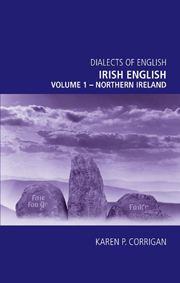2 - Phonetics and phonology
Published online by Cambridge University Press: 12 September 2012
Summary
Introduction
There is a housing estate in Armagh City called ‘Desert Lane’, which locals generally shorten to ‘The Desert’ and which was home to a number of families whose surname was ‘Campbell’ during the early phase of ‘The Troubles’ when the British Army had just been deployed there. In the local accent, the medial /b/ in the second syllable of this surname is usually elided. This caused great consternation at an army checkpoint that stopped one of the Campbell sons who kept responding [kæməl əv ðə dεzəɹt] when asked for his name and address (§2.3.2). There are many such narratives surrounding miscommunications between local inhabitants and others who are not familiar with the nuances of their accent which are the focus of this chapter (Grabe et al. 2005). Indeed, Todd (1989: 348, §6.4.2) argues that there is the potential for miscommunication (or at the very least ethnic differentiation) generated by phonetic contrasts even within NI between Protestant and Roman Catholic speakers.
These and related issues (including the extent to which such differences can be observed in informant responses to the tasks described in §1.3.2) will therefore be the focus here. To begin with, the terminology critical for an understanding of phonetics/phonology in NIE/US is out-lined. Then, the characteristics and potential sources of MUE/SUE/US segmental (consonants and vowels) and suprasegmental (prosody) features are introduced highlighting certain spatial/social differences.
- Type
- Chapter
- Information
- Irish English, volume 1 - Northern Ireland , pp. 29 - 50Publisher: Edinburgh University PressPrint publication year: 2010



